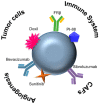Targeting Tumor Microenvironment for Cancer Therapy
- PMID: 30781344
- PMCID: PMC6413095
- DOI: 10.3390/ijms20040840
Targeting Tumor Microenvironment for Cancer Therapy
Abstract
Cancer development is highly associated to the physiological state of the tumor microenvironment (TME). Despite the existing heterogeneity of tumors from the same or from different anatomical locations, common features can be found in the TME maturation of epithelial-derived tumors. Genetic alterations in tumor cells result in hyperplasia, uncontrolled growth, resistance to apoptosis, and metabolic shift towards anaerobic glycolysis (Warburg effect). These events create hypoxia, oxidative stress and acidosis within the TME triggering an adjustment of the extracellular matrix (ECM), a response from neighbor stromal cells (e.g., fibroblasts) and immune cells (lymphocytes and macrophages), inducing angiogenesis and, ultimately, resulting in metastasis. Exosomes secreted by TME cells are central players in all these events. The TME profile is preponderant on prognosis and impacts efficacy of anti-cancer therapies. Hence, a big effort has been made to develop new therapeutic strategies towards a more efficient targeting of TME. These efforts focus on: (i) therapeutic strategies targeting TME components, extending from conventional therapeutics, to combined therapies and nanomedicines; and (ii) the development of models that accurately resemble the TME for bench investigations, including tumor-tissue explants, "tumor on a chip" or multicellular tumor-spheroids.
Keywords: Tumor microenvironment; cancer therapy; models for tumor microenvironment study; nanomedicines; tumor development.
Conflict of interest statement
The authors declare no conflict of interest.
Figures




References
Publication types
MeSH terms
Grants and funding
LinkOut - more resources
Full Text Sources
Other Literature Sources

